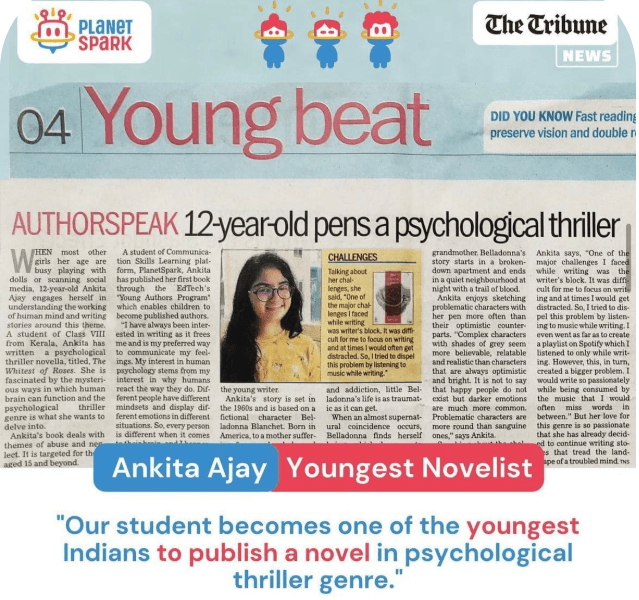Mahatma Gandhi Essay for Students (Short & Long Essay)

Table of Contents
- Short Essay on Mahatma Gandhi (150 Words)
- Long Essay on Mahatma Gandhi (500+ Words)
- 10 Interesting Facts About Mahatma Gandhi
- Major Movements Led by Mahatma Gandhi
- How to Write an Essay on Mahatma Gandhi – Step-by-Step Struc
- Boost Your Child’s Essay and Creative Writing Skills with Pl
- Final Thoughts
- Frequently Asked Questions
Looking for a well-written essay on Mahatma Gandhi for school homework, exams, or speech writing? This blog has everything you need a short essay, a long and detailed essay, key facts, important movements, and a step-by-step guide to writing an impactful essay on the Father of the Nation.
Short Essay on Mahatma Gandhi (150 Words)
Mahatma Gandhi, also known as Bapu, was one of the greatest leaders of India. He was born on October 2, 1869, in Porbandar, Gujarat. Gandhi strongly believed in truth (Satya) and non-violence (Ahimsa). He played a vital role in India’s freedom struggle by leading peaceful movements like the Dandi March and the Quit India Movement.
He always wore simple clothes made of khadi and lived a very humble life. Gandhi encouraged Indians to boycott British goods and rely on Indian-made products. His teachings continue to inspire people all over the world. He was tragically assassinated on January 30, 1948, but his legacy lives on. Mahatma Gandhi’s life teaches us to be brave, kind, honest, and peaceful in all situations.
Explore simple creative writing tips that help children write better essays.
Creative Writing for Kids – Stories, Activities & More
Long Essay on Mahatma Gandhi (500+ Words)
Introduction
Mahatma Gandhi, born as Mohandas Karamchand Gandhi, was a revolutionary leader who changed the course of Indian history. His philosophy of non-violence and truth became the foundation of India’s freedom struggle. He is known across the world as the symbol of peace, justice, and unity.
Early Life and Education
Gandhi was born on October 2, 1869, in Porbandar, Gujarat. His father was the Diwan (chief minister) of the state, and his mother was a deeply religious woman. As a child, Gandhi was shy but very honest. He went to London to study law and became a barrister. After his education, he moved to South Africa where he first experienced racial injustice. This deeply affected him and led to the beginning of his activism.
Role in Indian Freedom Struggle
Gandhi returned to India in 1915 and soon became a key figure in the independence movement. Unlike other leaders, he promoted non-violent resistance as the primary tool for fighting the British. Some of the most well-known movements he led include:
Champaran Satyagraha (1917)
Kheda Movement (1918)
Non-Cooperation Movement (1920)
Salt Satyagraha / Dandi March (1930)
Quit India Movement (1942)
His approach united people across castes, religions, and regions. He encouraged Indians to spin their own clothes, boycott British goods, and take pride in Indian culture.
Beliefs and Philosophy
Gandhi lived a life based on strong values:
Truth – Always be truthful and honest
Non-violence – Never harm others, physically or emotionally
Swadeshi – Support local products and businesses
Sarvodaya – Welfare of all
He believed that true independence begins with self-discipline and moral strength.
Legacy
Mahatma Gandhi’s legacy is not limited to India. Global leaders like Martin Luther King Jr. and Nelson Mandela were deeply inspired by his principles. His birthday, 2nd October, is celebrated as Gandhi Jayanti in India and International Day of Non-Violence globally. He continues to be a symbol of peaceful resistance and human rights.
"Want your child to express great ideas through structured essays? PlanetSpark’s creative writing program helps them think, write, and express better"

Great writers aren’t born. They’re coached. Discover how PlanetSpark turns young minds into confident communicators."
Book a demo session now
10 Interesting Facts About Mahatma Gandhi
Gandhi was nominated for the Nobel Peace Prize five times but never received it
He studied law in London and later practiced in South Africa
Gandhi led his first major protest in India during the Champaran Satyagraha
He walked 241 miles during the Salt March in 1930
Gandhi’s principles inspired global leaders like Nelson Mandela and Martin Luther King Jr.
He only wore khadi, a hand-spun cloth, to support Indian weavers
He was imprisoned 13 times during India’s freedom struggle
His autobiography is titled “The Story of My Experiments with Truth”
Gandhi’s life was based on vegetarianism and simplicity
He was assassinated on January 30, 1948, by Nathuram Godse
Major Movements Led by Mahatma Gandhi
| Movement | Year | Objective |
|---|---|---|
| Champaran Satyagraha | 1917 | Farmers' rights against forced indigo cultivation |
| Kheda Movement | 1918 | Relief for farmers from tax payment after crop loss |
| Non-Cooperation | 1920–1922 | Boycott of British goods and institutions |
| Salt March (Dandi) | 1930 | Protest against salt tax |
| Quit India Movement | 1942 | Demand for immediate end of British rule |
"Essay writing becomes impactful when kids learn to structure and express clearly. PlanetSpark makes it happen, one word at a time"
How to Write an Essay on Mahatma Gandhi – Step-by-Step Structure
A good essay follows a clear format. Here's a simplified structure students can use:
1. Introduction
Begin with a hook – a strong fact or quote about Gandhi. Briefly explain who he was and why he is important. End the paragraph by stating what the essay will cover.
2. Body Paragraphs
Divide the main content into logical sections.
Early Life and Education – Where he was born, how he grew up, what shaped his thinking
Freedom Struggle – Mention key movements he led and how he used non-violence
Values and Philosophy – Talk about his beliefs in truth, peace, simplicity, and self-reliance
Legacy – Explain how his ideas continue to influence the world
Each paragraph should have a clear topic sentence and 2–3 supporting details or examples.
3. Conclusion
Summarise the key points of the essay. End with a takeaway or life lesson children can learn from Gandhi’s story.
"Does your child struggle with writing structure? PlanetSpark’s 1:1 training helps children write powerful, well-structured essays"
Read More about tips on essay writing for kids - Essay Writing for Kids – A Complete Guide

Boost Your Child’s Essay and Creative Writing Skills with PlanetSpark
At PlanetSpark, we help children go beyond memorised essays and build real writing skills that improve with every session.
1:1 Personal Trainers for Every Child
Each student is matched with a certified trainer who delivers live, personalised classes. Trainers understand each child’s learning style and help them improve grammar, vocabulary, fluency, and structure.Personalised Curriculum and Learning Roadmap
We begin with a skill assessment and build a customised writing plan. Lessons grow in complexity as your child progresses.SparkX – AI Video Feedback Tool
Children submit speeches and stories. Our AI tool gives detailed feedback on clarity, grammar, body language, and more.AI-Led Practice Sessions
Students practise speeches, storytelling, and answers with our AI coach that provides instant feedback.Spark Diary
A digital writing journal where kids write daily reflections, stories, and poems. This builds consistency, creativity, and clarity.Gamified Learning Modules
Fun activities like Spell Knockout, Grammar Guru, Word Wisdom, and Fresh Quizzes make writing practice engaging.Structured Parent-Teacher Meetings (PTMs)
Parents receive regular reports and meet with trainers to discuss progress, goals, and action steps.Comprehensive Progress Reports
Our reports evaluate students on content quality, grammar, structure, critical thinking, confidence, and delivery skills.Learning Clubs and Communities
From Story Writing Clubs to Podcasting Circles, kids learn through collaboration, creativity, and peer appreciation.Sparkline – Safe Content Sharing Platform
Children share videos and stories in a safe online space moderated by PlanetSpark. It helps boost digital confidence.Contests, Showcases, and Recognition
We organise storytelling contests, writing challenges, and open mic sessions to give kids real opportunities to shine.SparkBee and SparkShop
Daily grammar and vocabulary challenges, along with interactive eBooks, make everyday learning fun and accessible.
"Want to see your child write amazing essays like this one? Book a free creative writing trial with PlanetSpark today"
Final Thoughts
Mahatma Gandhi was not just a political leader but a messenger of peace, truth, and justice. His life continues to inspire generations. When children learn to write about such great personalities, they don’t just build better language skills, they also learn important values.
With PlanetSpark’s personalised training and creative writing curriculum, your child can become a confident, thoughtful, and expressive writer.
Frequently Asked Questions
Q1. What is the best way to write an essay on Mahatma Gandhi?
The best approach is to follow a structured format: Start with an introduction that gives a brief overview of who Gandhi was and why he is important. Then divide the body into sections like his early life, key movements in the freedom struggle, and his core beliefs. Conclude with a short paragraph that summarises his legacy and personal impact. Keeping the language simple and using real facts will make the essay effective and easy to understand.
Q2. What are the three main values Gandhi believed in?
Mahatma Gandhi strongly believed in truth (Satya), non-violence (Ahimsa), and self-reliance (Swadeshi). He applied these values not just in his political work but also in everyday life. These principles continue to inspire people across the world and form the foundation of his teachings.
Q3. How can PlanetSpark help my child improve essay writing?
PlanetSpark offers 1:1 personal coaching with certified trainers who guide children in creative and academic writing. With customised learning plans, AI-based performance feedback (SparkX), daily writing practice via Spark Diary, and engaging activities, PlanetSpark helps kids write more clearly, confidently, and creatively.
Q4. For which classes is this Gandhi essay useful?
This blog is suitable for students from Classes 3 to 8. Younger children can use the short essay for school assignments or oral presentations, while older students can refer to the long essay for writing competitions, exams, or speeches. The writing structure and tips work across all levels.
Q5. What are some important movements led by Mahatma Gandhi?
Some of the most important movements led by Gandhi include the Champaran Satyagraha (1917), Kheda Movement (1918), Non-Cooperation Movement (1920–22), Salt Satyagraha or Dandi March (1930), and Quit India Movement (1942). These peaceful protests were key to India’s fight for independence.
Q6. How can students make their Mahatma Gandhi essay stand out?
Students can make their essay unique by including lesser-known facts, using quotes, adding a strong introduction, and expressing what Gandhi’s life means to them personally. Organising ideas with a clear structure and using simple but powerful language also helps improve quality. With guidance from PlanetSpark’s creative writing coaches, children learn how to express ideas originally and confidently.
Q7. Why should children write essays about leaders like Mahatma Gandhi?
Writing about leaders like Gandhi helps children learn about India’s history, values like honesty and non-violence, and how peaceful leadership can bring change. It also builds research, writing, and critical thinking skills, essential for school and beyond.
Q8. What is the ideal length of an essay for students in Classes 3 to 8?
For younger students (Classes 3–5), a short essay of 150–200 words works well. Older students (Classes 6–8) can write 300–500 words or more, depending on their skill level. At PlanetSpark, the curriculum is tailored by age and ability to help every child write effectively at their own pace.
Q9. Can PlanetSpark help with both essay and speech writing?
Yes. PlanetSpark’s creative writing and public speaking programs go hand in hand. Children learn how to structure essays, express their thoughts clearly, and turn those essays into speeches using voice modulation and confidence techniques, all through 1:1 personalised training.
Q10. How does PlanetSpark make essay writing easier and more enjoyable for kids?
PlanetSpark uses 1:1 coaching, gamified learning, AI feedback tools, and daily writing challenges to make writing fun and effective. Kids don’t just memorise essays, they learn how to write them from scratch, improving creativity, grammar, and fluency over time.
Personalized Communication Report
Record a video to get a AI generated personalized communication report for your child

Hi There, want to try these
tips for your child with
LIVE with our expert coach?
Let's check your child's
English fluency
